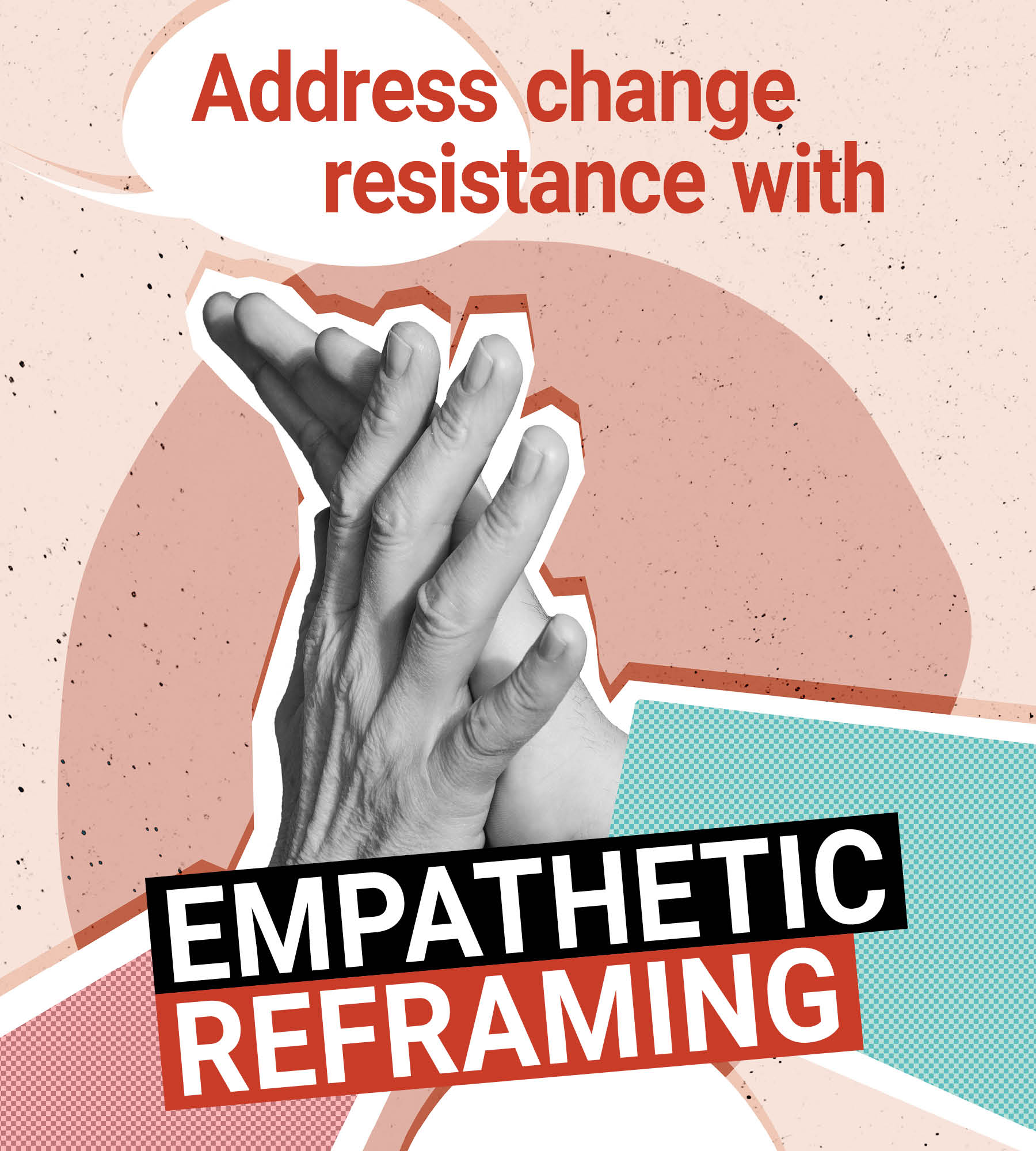Language
You can read the magazine in one of the following languages
In the dynamic landscape of organizational change, managers often find themselves grappling with resistance from team members. While change resistance is natural and common, navigating it effectively can make or break the success of change initiatives.
Employee opinions are not facts, but they do drive behavior, which is why they must be addressed if you’re to achieve high degrees of buy-in and commitment to change. This is where the powerful technique of cognitive reframing comes into play, offering managers a valuable way to respond to rational, psychological or political resistance and have a transformational influence on their people.
Reframing has been used in clinical psychotherapy for decades. It involves shifting the perspective of an individual or a situation by altering the meaning attributed to it. This, in turn, changes the person’s attitude or belief about the situation, leading to changes in their behavior.
A cliched reframe is the ‘glass half-empty versus half-full’ analogy. When we reframe, the meaning is shifted using alternative language that adds a different lens or angle through which to view the situation. For example, reframing an unexpected challenge as an opportunity to innovate or gain fresh experience can increase confidence, decrease the intensity of paralyzing negative emotions and lead to creative ideation and productive action.

When we reframe, the meaning is shifted using alternative language that adds a different lens or angle through which to view the situation.
A major caution here: simply ignoring others’ views and immediately flipping them around with the complete opposite can have an adverse effect, where people don’t feel acknowledged or valued and, consequently, dig their heels in.
The other reframing trap to avert is ‘spin’, often termed ‘putting lipstick on a pig’. This is a manipulative form of reframing communication, conveyed in the sender’s interest, not the receiver’s.
We can avoid these traps by empathizing with others and focusing the frame we convey on helping them navigate the uncertainty and exploration of complex transitions. Reinforcing interpersonal connection and trust is a critical prerequisite for an ethical reframe.
Here are a few tips on how to empathetically reframe situations during organizational change for maximum connection and influence.
Employees may resist change for rational reasons, pointing out problems in a proposed solution. Yet even if someone’s perspective of the change is ill-conceived or ill-informed, its existence is a real barrier to constructive action.
Listening empathetically to team members’ perspectives shows you value them. When people feel valued, they trust you and stay open to your influence. Not only that, but the interaction could also be an opportunity to have your own view of the change reframed by them. Their insights could highlight real, underlying issues and concerns with the proposed approach, trigger you to fix the problem or escalate to a project delivery team.

Here, saying something like, “I can see why you feel that way” or “That’s an interesting perspective; tell me more about that” will elicit useful insights to build off. Doing this – before sharing your alternative frame – helps you align to the clear starting point of their perspective.
If someone makes a broad statement like, “This change will kill our company”, it’s pretty hard to counter with anything other than a similar broad statement, like, “No, it won’t”.
To avoid this abstract absurdity, uncover specifics or encourage them to provide evidence of their claim. For example, ask one of the following questions:
● “How so?”
● “What specifically don’t you like about it?”
● “What makes you think that is the case?”
Their answer will be more specific and solvable, such as: “Well, the changes to our team structure will make our workload unmanageable.”
At this point, you could empathize and introduce a reframe. For example: “I can see why that is a concern and sustainably managing our workload is important.”
This approach offers validation and empathy.

“The restructure will change how we allocate and manage work, which means we have an opportunity to rethink our priorities and ways of working, rather than doing the same or more work within a new structure. We may not have all the answers yet, but we can work through it together.”
This approach offers a reframe. Of course, your reframe must be more than just words. It must be truthful and realistic.
Once you’ve listened carefully, empathized, drilled down into their concerns and shared your reframe, invite them to see it your way or to challenge your perspective further. This will confirm if you’ve influenced their belief and extend the opportunity to more closely align.
Example questions to ask here include:
● “What do you think of the perspective I’ve just shared?”
● “Do you think I might be wrong about that? I’m open to all views.”
● “How do you feel about it now that I’ve shared this with you?”
Often as managers, we take on the responsibility of having all the answers and the final say. However, there is power in following up your reframe with a question that confirms the outcome of your influence.
During change, managers own the message and should act as stewards of strategic change. But the message cannot be assumed to result in alignment of our strategic perspective (or frame). Alignment occurs following dialogue where it can be confirmed.
The effectiveness of managers in facilitating that dialogue goes a long way to determining the success of major change initiatives. Empathetic reframing is one of several techniques managers should use to achieve this.

Huw Thomas
Contributor Collective Member
Huw Thomas is a professional speaker, executive mentor and change leadership expert. He has worked with more than 75 organizations across four countries and 15-plus industries including banking, not-for-profits, media, pharmaceuticals and public services. Huw now owns and leads his own consulting business and is also a practicing Non-Executive Company Director and Chairman of a not-for-profit service company. For more information visit https://huwthomas.com.au/
